
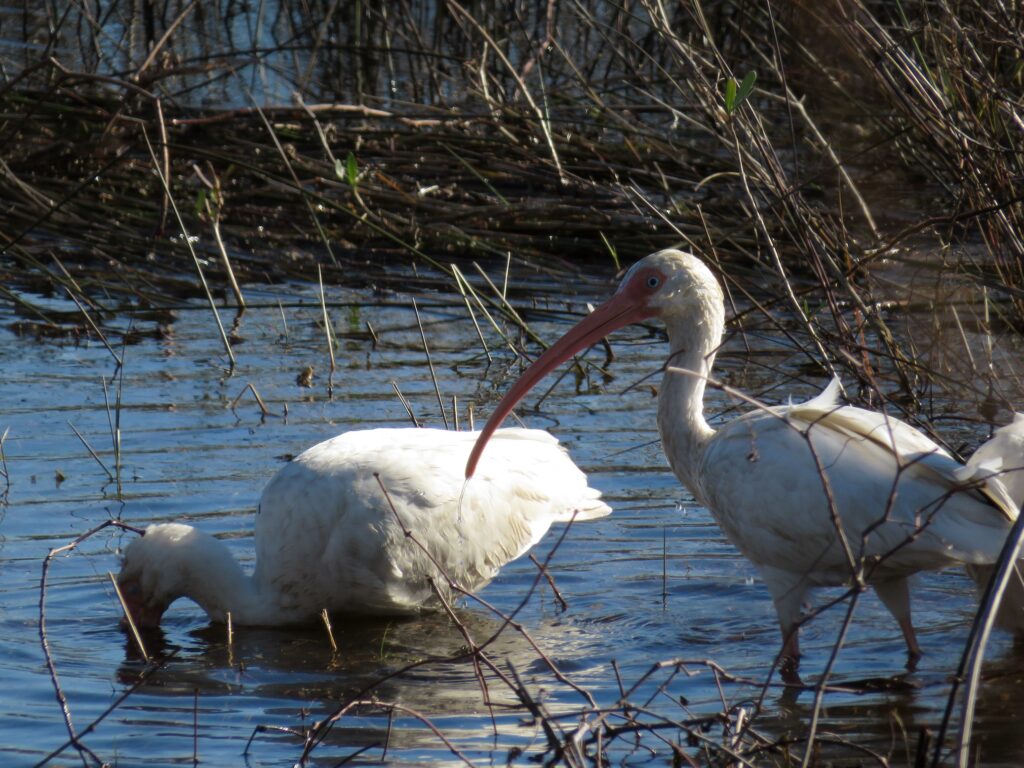

This week for Flora and Fauna Friday it’s a snowy crook-billed critter who’s not afraid to get its feet wet: the White Ibis (Eudocimus albus).
Breeding birds are an icy-white with a rosy-red face and strong bubblegum-pink legs. In flight their wings show tips of contrasting black. Immature birds are a patchwork of warm mocha-brown, cold snow-white, and soft gray. Their body has a streamlined profile and their neck is long and sinuous. Their eyes are a clear sky-blue and their long, drooping bill is dripping with that same bubblegum hue. Ibis are both compact and lean which gives off an athletic vibe. We have a second species of Ibis regularly seen on Edisto Island, but never commonly, called the Glossy Ibis (Plegadis falcinellus). A gorgeous bird of oily-black draining away from a cinnamon neck with dark beady eyes bordered by shining Xenon lines. Ibis are most closely related to our Roseate Spoonbills, outside of other Ibis.
The White Ibis is a common wading bird throughout the coastal plain of the Southeastern United States and Central America. They’re here year-round but their numbers ebb and flow as birds cycle between seasonally preferred habitats. In winter our populations peak as the birds chase warmer weather and better forage. White Ibis love wetlands. Stagger stepping while stabbing through stagnant stands of sedge or sod they forage and feed their way over the shallow waters of our state. They’re ever present every winter in our ephemerally flooded forests and fields as they descent in flocks upon the soggy soil. They’re partial to marsh lands as well and regularly plop down beside our Egrets along the pluffy tidal creeks. White Ibis are rarely seen alone, usually being accompanied by at least two if not two dozen compatriots. Occasionally, mass flocks of hundreds of birds will appear on farm fields following seasonal flooding. I’ve seen them in waves of thousands on the fields surrounding Russell Creek!
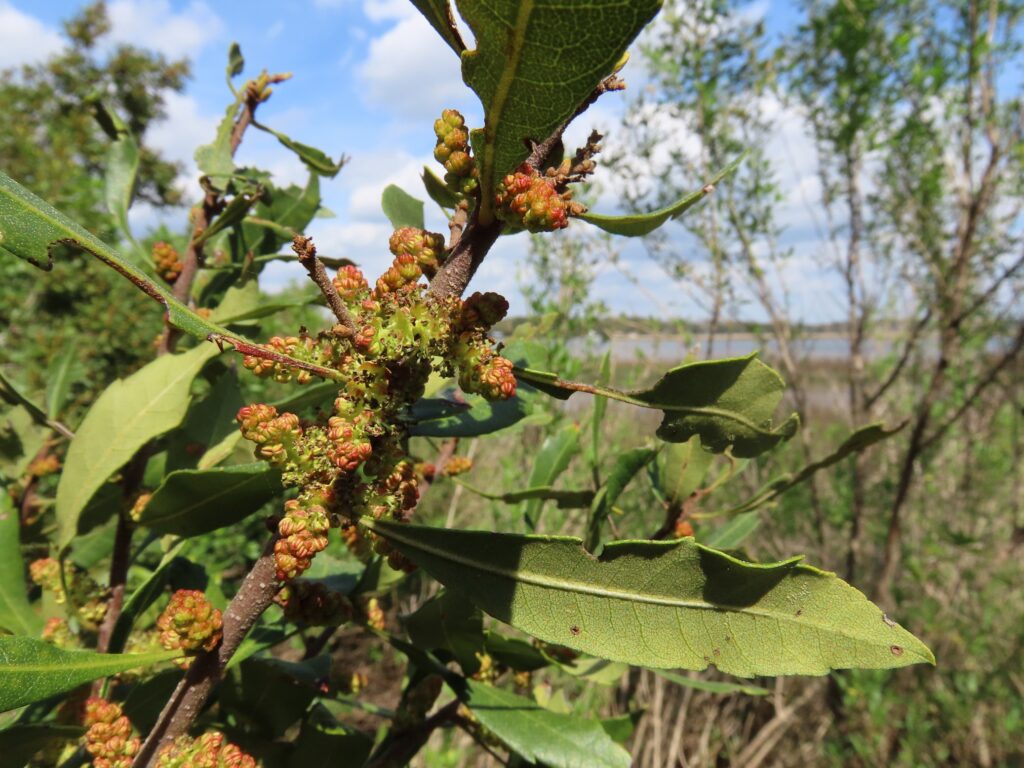
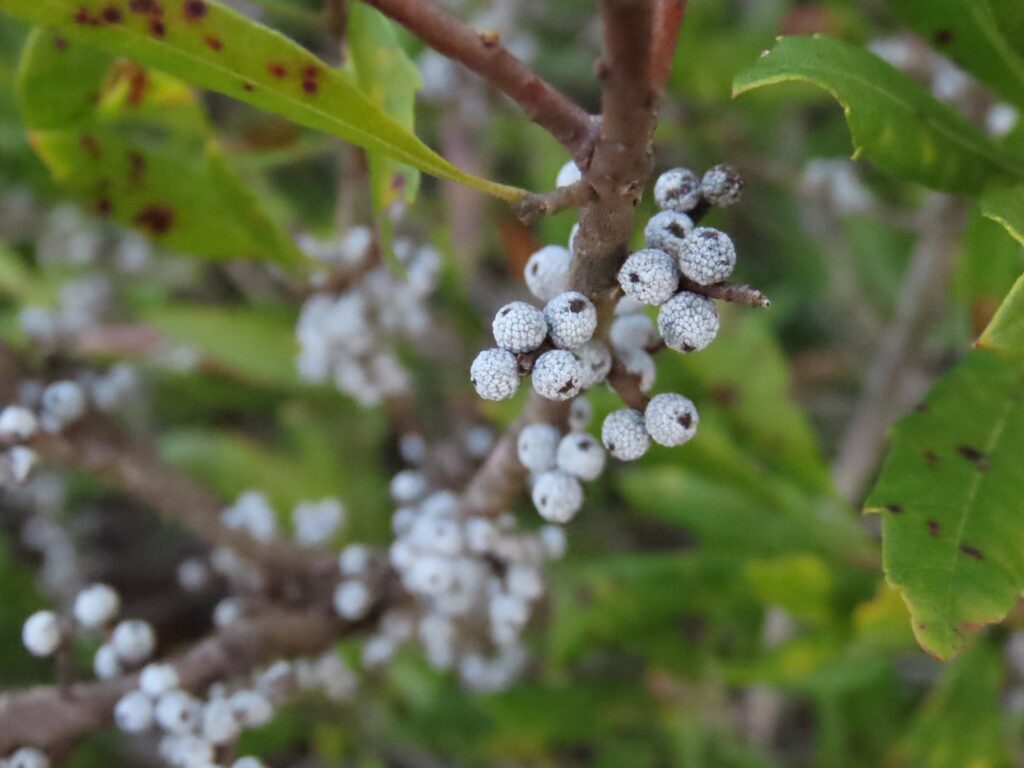
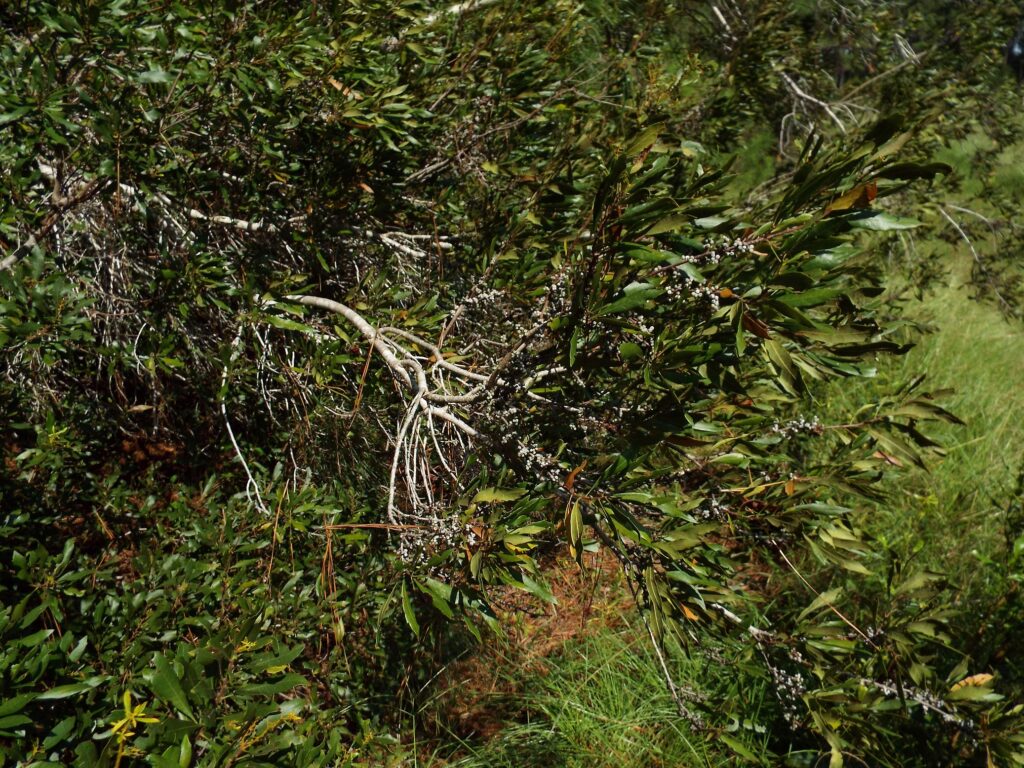
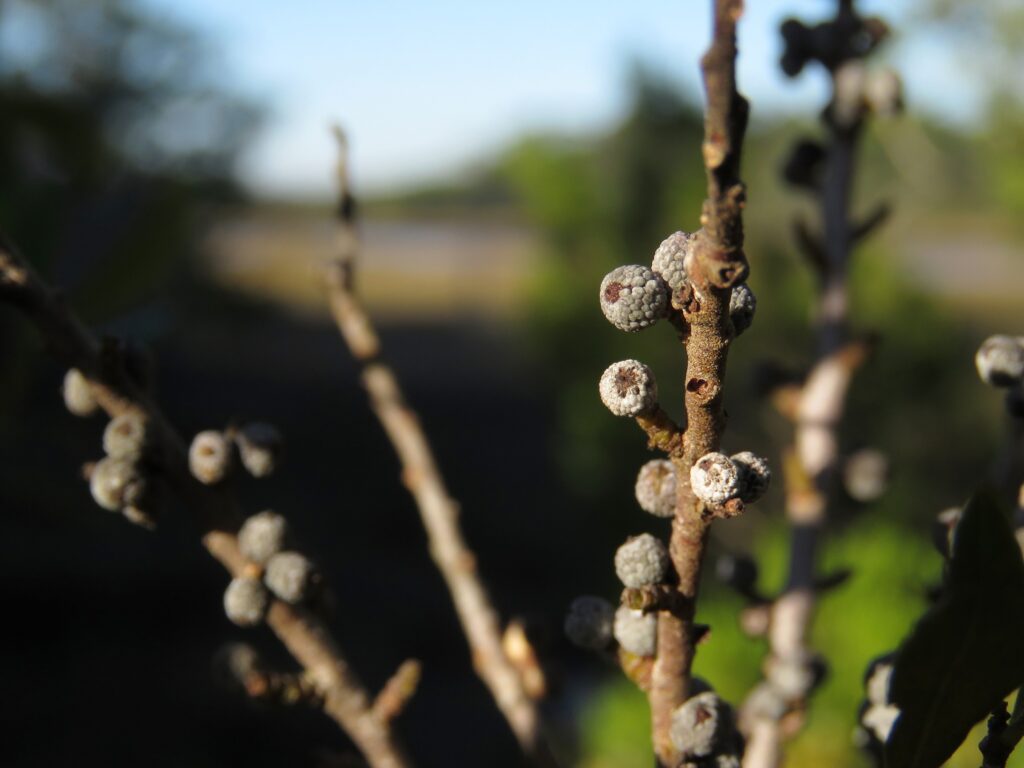
This week for Flora and Fauna Friday the subject is a flammable, fragrant foliage: the Southern Wax-Myrtle (Morella cerifera).
The Southern Wax-Myrtle is one of those inescapable fixtures of Edisto’s flora. A shrub found on every causeway, woodlot, lawn, and hammock. It is quick to grow almost anywhere thanks to its ability to fix atmospheric nitrogen and tolerance of flooding, drought, and salinity. It’s unkempt, swelling body of leaves hovers above the ground on gnarled, twisting trunks of gray ringed in white. The leaves are simple and plain of shape but more unique in their details. Those piney, evergreen leaves wear a dull sheen pocked by minute dimples while radiating an aura of yellow. That appearance is belayed by a trait of Wax-Myrtle, its fragrance. Wax-Myrtle has a spicy, pungent scent produced by a cocktail of chemicals found in the yellow pinprick resin glands that pepper its leaves. These chemicals ward off herbivores of both the six and four-legged varieties. Yet, Wax-Myrtle has use for the two-legged types.
Wax-Myrtles are a dioecious plant, having both male and female trees. Its flowers are a twisted affair of green and red nodules that arise from its stems. Male flowers are larger and more open but both sexes rather innocuous. Female Wax-Myrtles come to bear a buffet of berries as we enter autumn but these teeny blue-gray berries are not sweet, they’re greasy. Or more precisely, they’re waxy. The berries of the Southern Wax-Myrtle are the staple in the winter diet of the Myrtle Warbler. These normally insectivorous birds have developed a mutualistic relationship with the Wax-Myrtle. The fatty fruits provide an easily digestible, calorie dense bounty for the warbler to survive on through the winter. In return these petite songbirds spread the seeds of the Wax-Myrtle throughout every inch of South Carolina. The berries are also of use to people as they can be gathered and boiled to yield wax for candle making. This is where the wax for bayberry candles comes from. This waxy coating also extends to the leaves of Wax-Myrtle making them both drought resistant and highly flammable. So I wouldn’t recommend planting them next to your fire pit or propane tank.
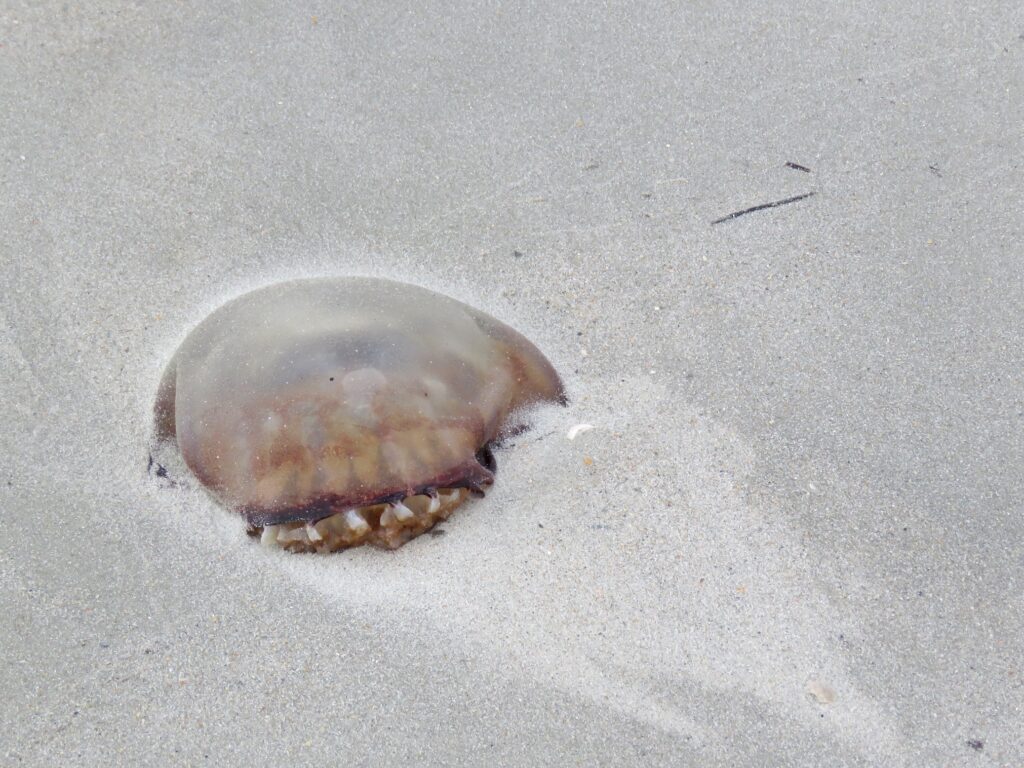
This week for Flora and Fauna Friday we have a gelatinous, spherical, planktonic animal who gets eaten in interesting ways: Cannonball Jelly (Stromolophus meleagris).
The Cannonball Jelly is the most common Jellyfish in the tidal rivers surrounding Edisto Island. The Cannonball Jelly, like most Jellyfish, is planktonic. They are totally subject to the whims of the ocean’s currents. From summer through fall, their numbers surge along the coast. They can often be seen floating past in blooms of dozens to hundreds or washed up en masse on beaches after storms.
Their common name accurately describes their simplistic shape, a helmet-like dome trailed by stubby, frayed tentacles. They can reach up to ten inches across and are quite drab in color, with only a washed-out burgundy belt to accent their translucent milky-gray complexion. Their stumpy, fluffy tentacles are rather unassuming as well and indeed lack pretty much any punch. They mainly feed on microscopic animals, including all manner of larval crustaceans, molluscs, and fish. Cannonball Jellies are still toxic but rather than wielding explosively venomous nematocysts, they only exude a poisonous slime. They’re difficult to get stung by and the effects are usually just mild irritation, to both parties.
The Cannonball Jelly is probably best known for getting eaten. They are a staple in the diets of the endangered Leatherback Sea Turtle (Dermochelys coriacea). Leatherbacks are specially adapted to eating Jellyfish and our rotund Jelly is quite the appetizing meal. Jellyfish are also eaten by people, just usually not Americans. The Cannonball Jelly fishery is a developing economy here in the Southeast and a potentially profitable export to Asian countries, where re-hydrated Jellyfish is a regular menu item. At the moment the business is exclusive to Georgia. Compared to most Jellyfish the Cannonball has a rather solid constitution, feeling more like rubber than Jell-O in the hand. This makes them well suited for harvest, drying, and subsequent eating!
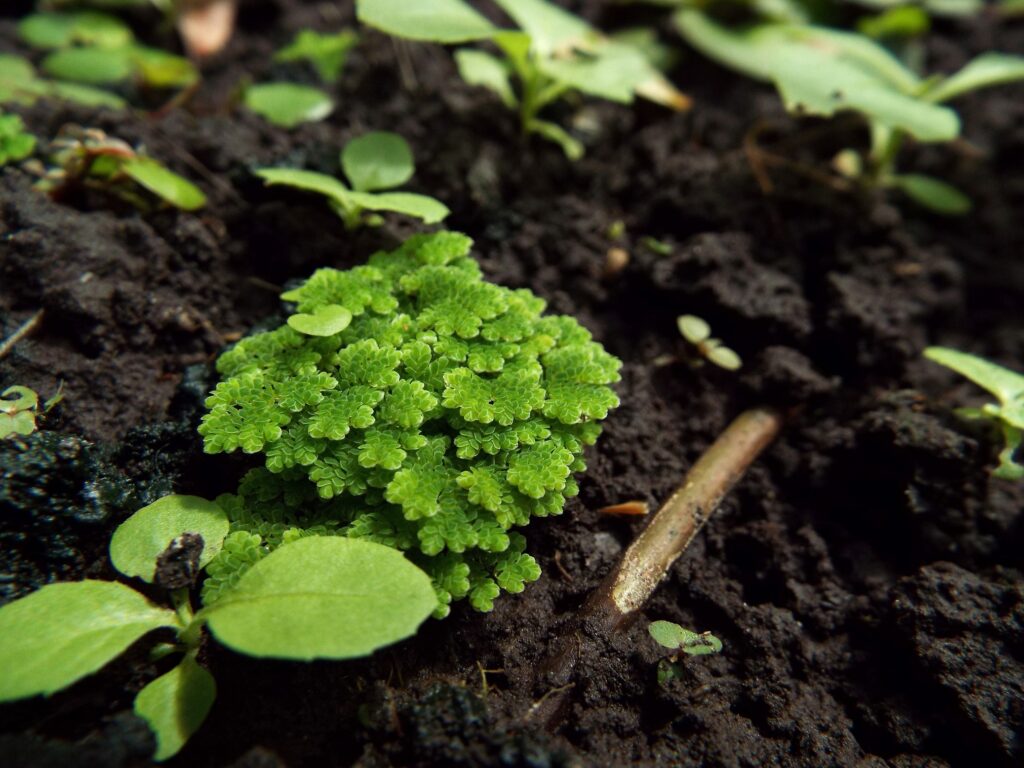
This week for Flora and Fauna Friday we have a miniature, multicolored, floating fern: Eastern Mosquito Fern (Azolla caroliniana).
Mosquito Fern is much like Duckweed. It’s a tiny planktonic plant found in stagnant wetlands around the Lowcountry. Wooded ponds and marshes are where it makes its home. It sets no roots, only drinking nomadic nourishment from the surface of a swamp. Mosquito fern ranges from an emerald-green to a brick-red glowing in a halo of pink. Mosquito Fern turns red when exposed to excessive sunlight. This is sort of like tanning in humans. Many plants do this but not as obviously. This red color comes from pigments in the plant that act to block sunlight from entering its cells. Typically, plants are trying to get as much light as possible but there’s also an upper limit to how much they can photosynthesize. If more light enters the plant than it can use, the plant could overheat and cook. So Mosquito Fern, which might find itself in the center of a shallow sunny pond in summer, has a tendency to don a protective ruby sunscreen.
Duckweed is always verdant, which makes the often blushed Mosquito Fern easy to spot from a distance. Upon closer examination, Mosquito Fern has stems and leaves with a central set of roots. It takes on a jagged, branching shape in a circular arrangement with age where duckweed sticks to two or three ovular leaves. The least obvious but most significant difference between the two is that Mosquito Fern can fix nitrogen. This gives them a distinct niche apart from Duckweed which must rely on water borne nitrogen for growth. It also means Mosquito Fern is extra-rich in proteins, making it a great alternative livestock feed. Lastly, Duckweed is a flowering plant and Mosquito Fern is a true fern, if that wasn’t already obvious. The two fill similar niches but are vastly different physiologically.





This week for Flora and Fauna Friday it’s our whistling, crested, creek duck: Hooded Merganser (Lophodytes cucullatus).
Beneath the rushes a flash signals a distant splash upon the creek. A convoy of murky birds putter into view. Bright flags of untainted white painted on glistening coal-black flap and flare amidst more modest walnut wigs. Dingy gray and varnished chestnut trim these swimmer’s hulls. A golden glance cuts your way as unease ignites across the water. Explosive splashes and whistling wings send the murky birds off to collect upon another creek corner.
The Hooded Merganser is an average-sized duck that’s anything but average. Mergansers as a group are odd ducks. They’re one of many species diving duck, ducks who actively dive beneath the water to feed, yet they’re also piscivorous. In order for these ducks to catch fish, they’ve developed a long, thin, hooked bill with serrations, much like a Cormorant’s. Hooded Mergansers are extra odd when it comes to their appearance. Females are overly drab. Their plumage is a muddy walnut-brown across with only an orange lower lip for accent. Males on the other hand are quite the showstopper. Their flanks are a vibrant chestnut, belly snow-white, and back and head a pure, deep black. That back is streaked with scant but heavy white lines and their head bears a centurion’s crest filled with brilliant white that tapers to a shining topaz eye.
Hooded Mergansers are a common cold-weather sight throughout the tidal creeks and impoundments of Edisto Island. They’re rarely ever alone and usually in groups of up to two dozen. They can often be spotted repeatedly diving over deep pools in search of shrimp and fish. Hooded Mergansers are practically mute, issuing no quacks or grunts. However, in flight their wings release a steady pulsing whistle, just like a Wood Duck.
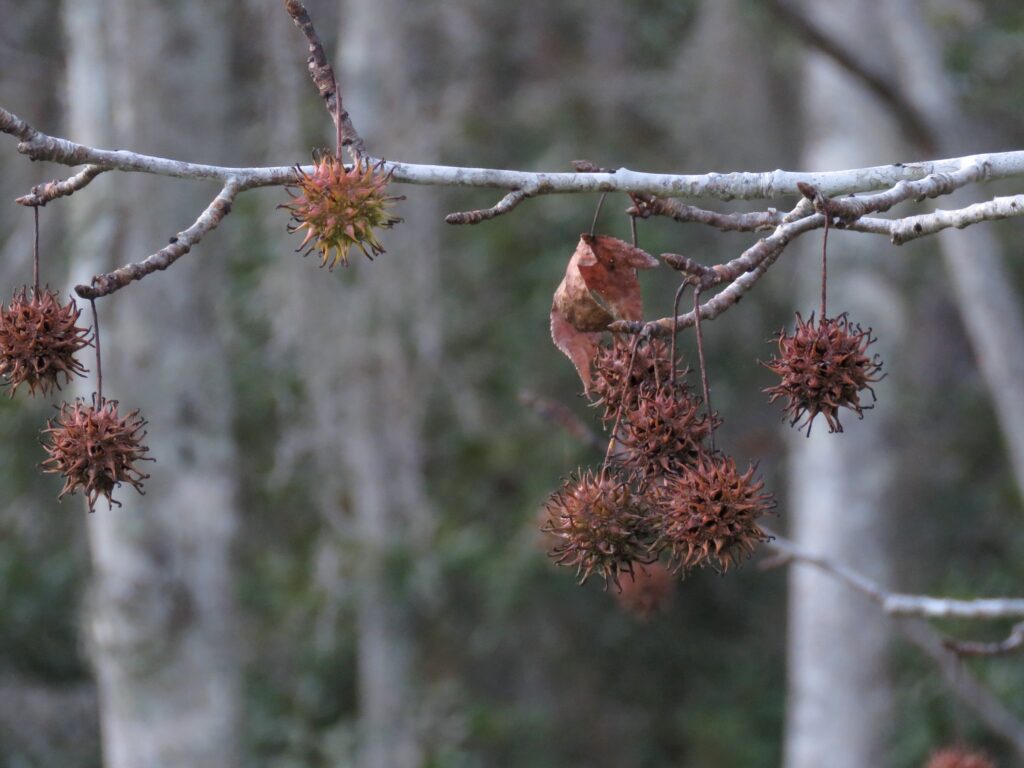
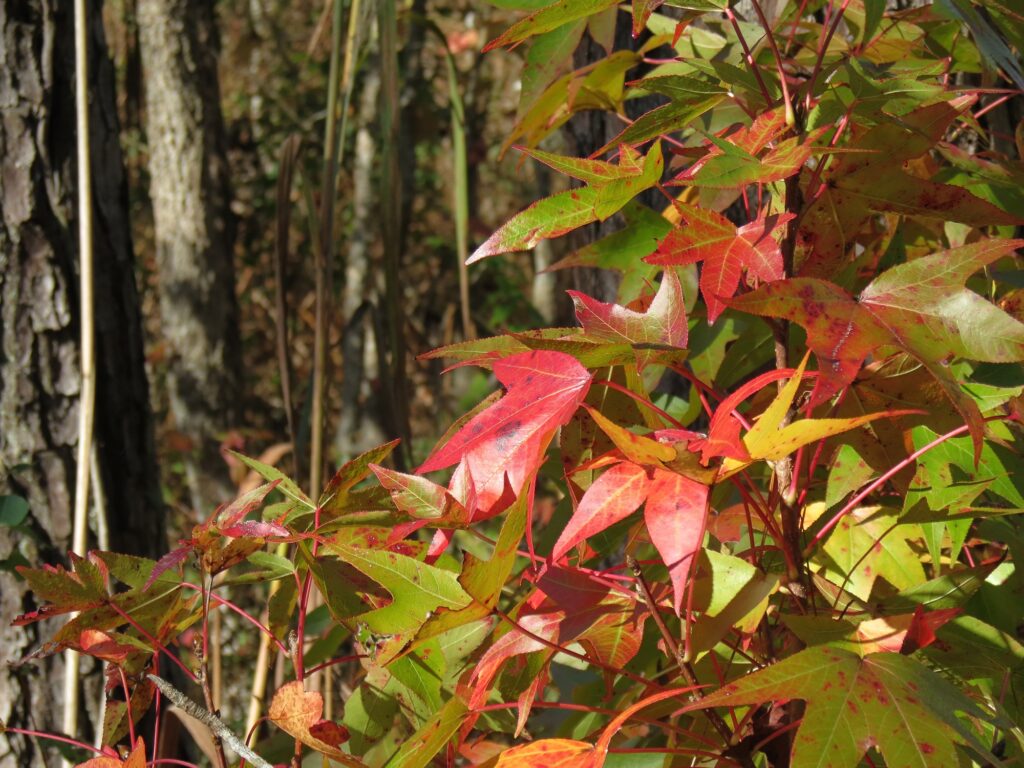

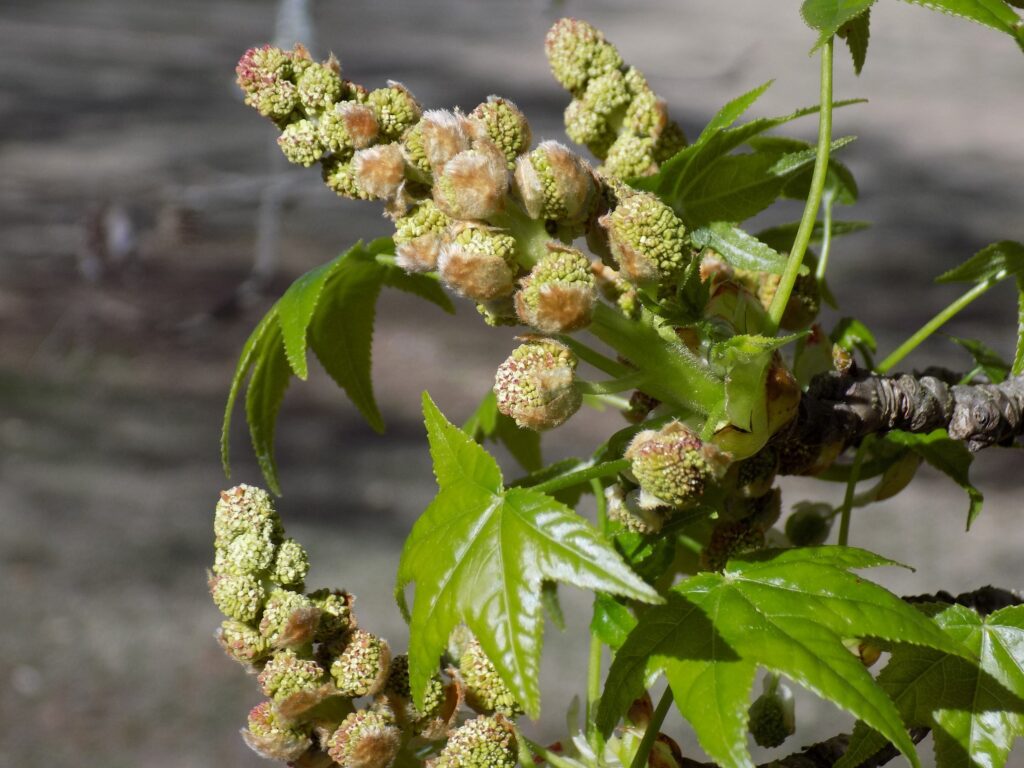
This week for Flora and Fauna Friday is the strangler of drainage, fallower of fields, and perforator of heels: American Sweetgum, Liquidambar styraciflua.
Sweetgum is a fast growing tree. It doesn’t often reach monstrous proportions but can attain a good size. Its bark is pale with thick corky bark in thin vertical strips. Sweetgum leaves are five-lobed and about four inches wide. Spring through summer their leaves are lime-peel-green. In fall they display a palette from lemon-yellow, through mandarin-orange, into the deepest grapefruit-purple you’ve ever seen on a tree. Sweetgum is best known for its fruit: a spherical woody deal full of holes and covered in spikes. This fruit is a multiple of capsules. Each hole contains a single tiny seed with a tiny wing. Sweetgum seeds are a favorite food of Chickadees, Goldfinches, Titmice, and House Finches.
Other than the lovably lumberable Loblolly Pine, the Sweetgum is the most unavoidable tree of the Lowcountry. If the soil is poorly drained, or even just a little damp, there will be a Sweetgum within a stone’s throw. They’re like wet on water in our low lying lands. As you could imply, Sweetgum is highly tolerant of saturated soils. Not as much as say Red Maple or Blackgum but enough to give it purchase most places. This affinity for moisture puts it in direct dispute with drainage. Sweetgum loves ditches and will clog them as quick as you can blink.
In forest ecology, Sweetgum is what’s known as a pioneer species. It’s one of the first trees to return to a fallow field or a clearcut forest. Those small-winged seeds scatter easily on the wind and their sheer volume improves their odds. Once germinated, Sweetgum does well in full sun, grows fast, and outcompetes most grasses. This lets it establish in fallow fields and meadows and quickly grow above the grasses and forbs to begin the process of reforestation. As pioneer tree species take hold and spread, they facilitate the introduction of longer lived, mature forest trees.


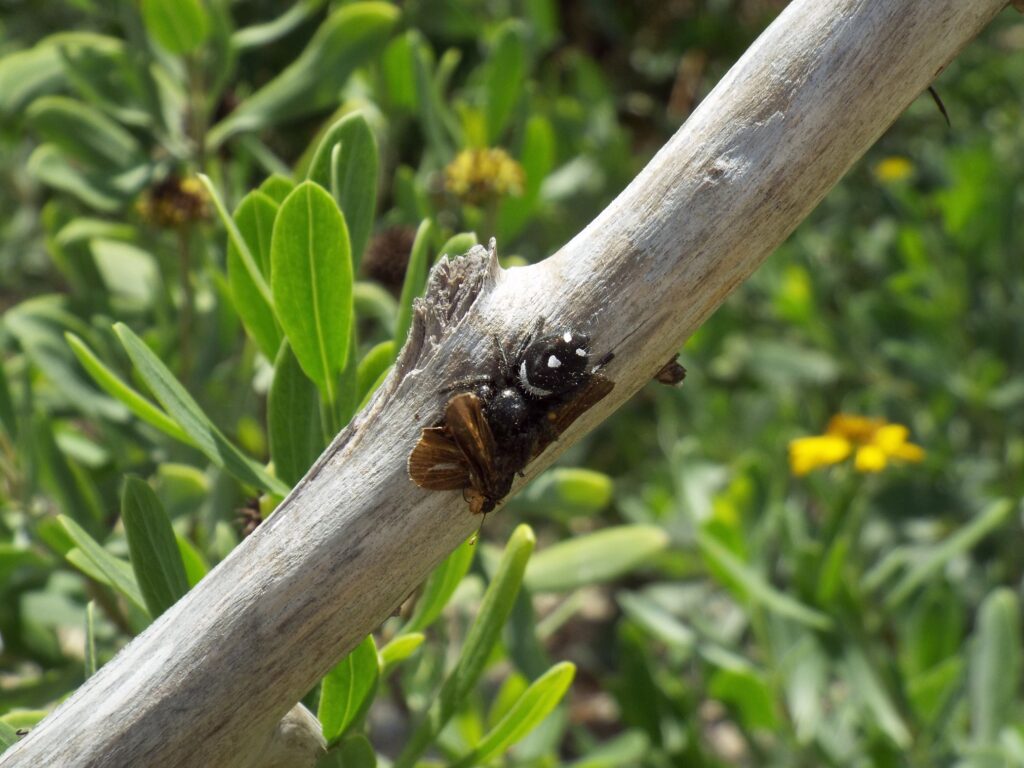

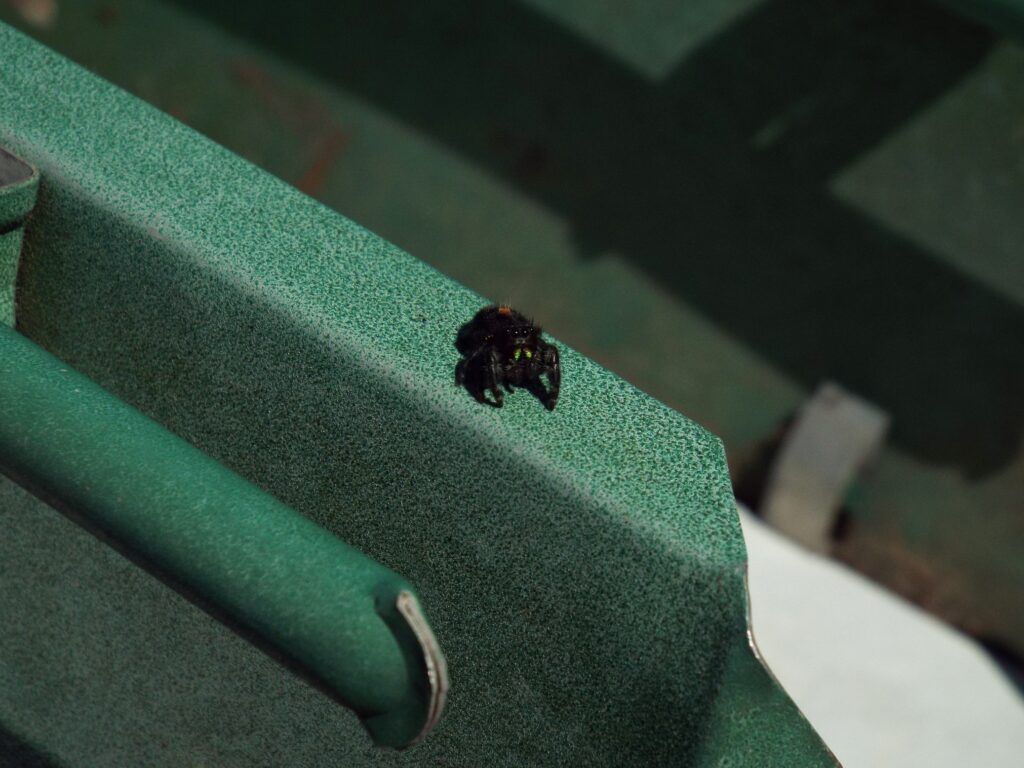
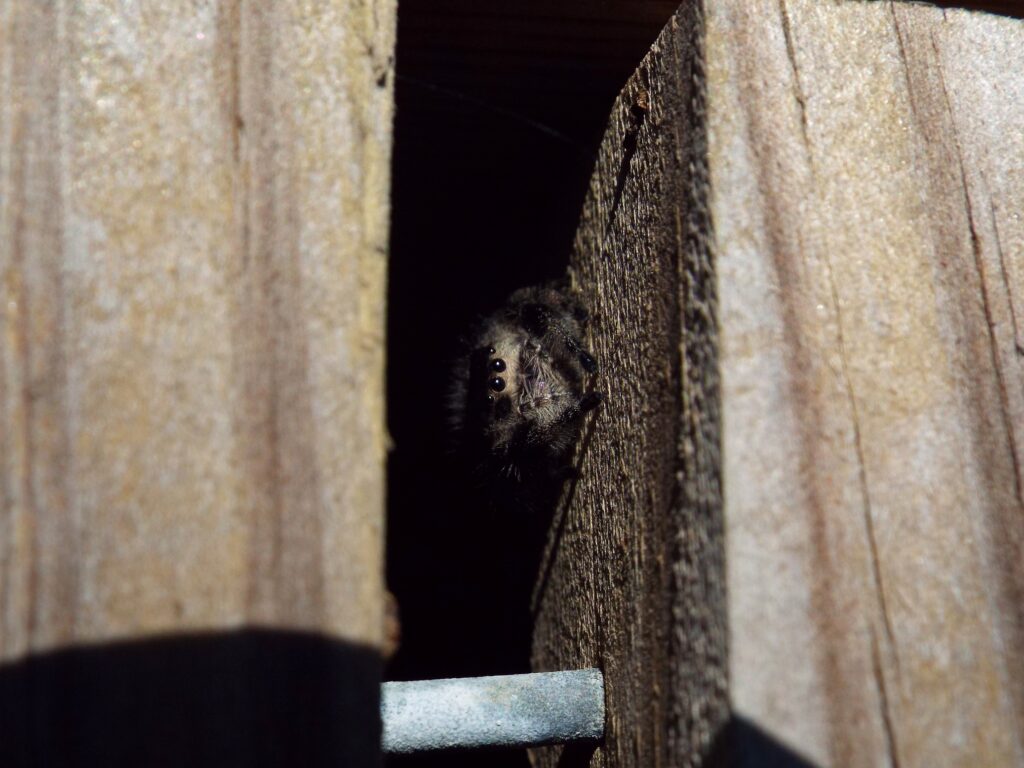
This week for Flora and Fauna Friday we have a precocious and handsome arachnid: the Regal Jumper (Phidippus regius).
The Regal Jumper is a large member of the Jumping Spider family, Salticidae, who often reaches three-quarters of an inch in length. They’re common in maritime forests, meadows, and yards across Edisto Island. They most oft pitch their silken sleeping tents in the cracks or hollows of trees but are immensely fond of sunny birdhouses too. Their body is stubby and monochrome with cold-white markings on a matte-black background. When seen overhead, their abdomen bears an inverted smiley face, nose and all. Their bottomless, polished eyes of glass stare deep into yours as their jaws glitter in irresistible iridescence. Shimmering jade or glimmering variegation of sapphire and amethyst pierce out behind bushy gray whiskers, distracting from mammoth fangs like eagle talons. As you turn your head to study this enticing creature it pivots in place. Its gaze is directly on your face, watching you warily all the while. Fully conscious of your intrusion, its annoyance is palpable as it firmly stands its ground against the trespass of your presence.
Jumping Spiders are particularly personable in the spider world due to their large, forward-facing eyes and bold personalities. Regal Jumpers are no exception, although they’re more ornery than most. These traits help them avoid the scorn other spiders receive from us but are merely consequences of their ecology. If a Black Widow is a viper and an Orbweaver a lion, the Jumping Spider is a fox. Jumping Spiders do not spin webs nor do they lie in wait for a premeditated ambush, they hunt their prey on foot with wit and perception. Regal Jumpers patrol leaf, limb, and litter alike for careless insects. They use their large forward eyes and three extra side sets to see their world in great detail and depth. When they locate prey, they place a tether of silk to the substrate beneath them before explosively propelling themselves forward, arms outstretched, onto the backs of their quarry. If they miss, their silken lifeline breaks their fall. Jumping Spiders launch themselves many times their body length through the assistance of a specialized circulatory system. Rather than develop oversized muscles, like grasshoppers, Jumping Spiders use their hemolymph (AKA “bug-blood”) like a hydraulic suspension. They swell their leg muscles with blood to catapult forward. Like every spider, Regal Jumpers subdue their prey with venom. They do not bite unless roughly handled and their venom is harmless, albeit painful.

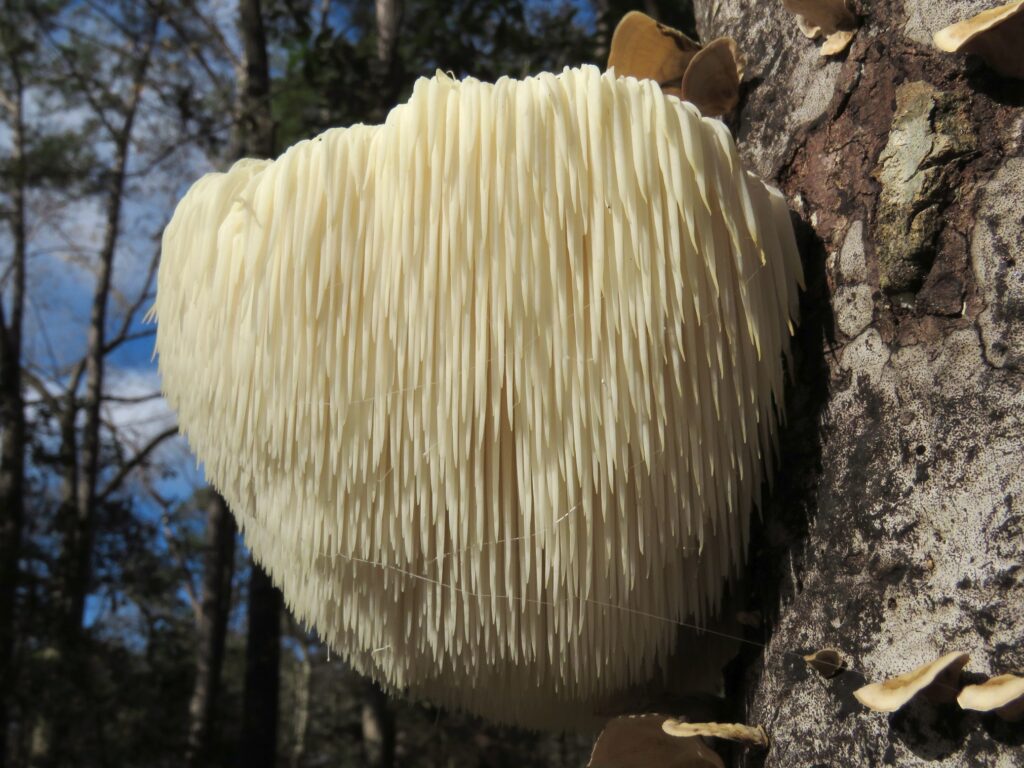
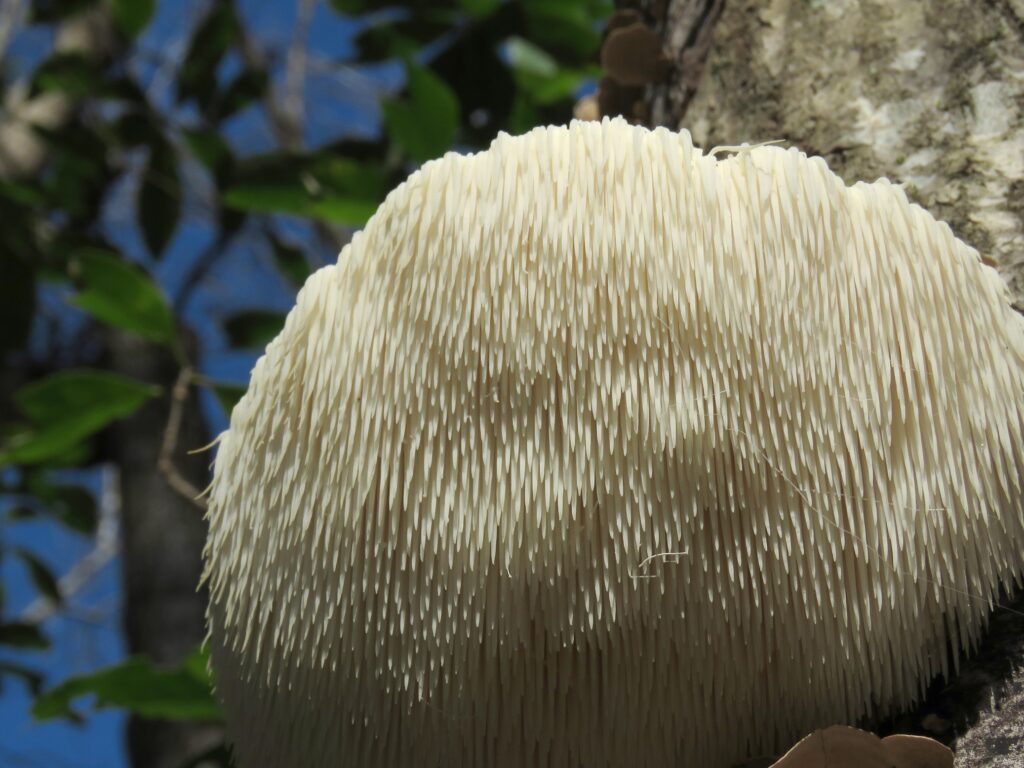

This week for Flora and Fauna Friday it’s a flag-esque fungus flown in the frigid forests of Edisto: Lion’s Mane (Hericium erinaceus).
Ivory icicles sparkle in the cold sunlight. Frozen frothing in the downward flow of a Water Oak whose bark has long since breached, spilling, streaming onto the forest floor in trickles and floods of dust and cordwood. Lion’s Mane is new life in the dead of winter, born on high from the carcass of an oak in the winds of winter. A coalescence of snowy tentacles weep, lying neatly over their inner orb. A transient child that reaches into the heart of its mother and leads her spirit out into the fresh air for a final gasp.
Lion’s Mane is a common and prolific mushroom throughout the hardwood forests of the northern hemisphere. On Edisto, you’ll most often find them fruiting many feet overhead amidst the woodlands, secured tightly to the surface of a sickly or stricken species of Red Oak, chiefly Water and Darlington Oaks. They feed on the decaying wood of their parent tree. They fruit in winter high in the snag to spread their spores as far as possible on the coattails of the breeze. Lion’s Mane is fully edible but often hard to collect. Their penthouse position protects the soft and substantial mushroom from the hungry mouths of passing mammals, whether mice or man.
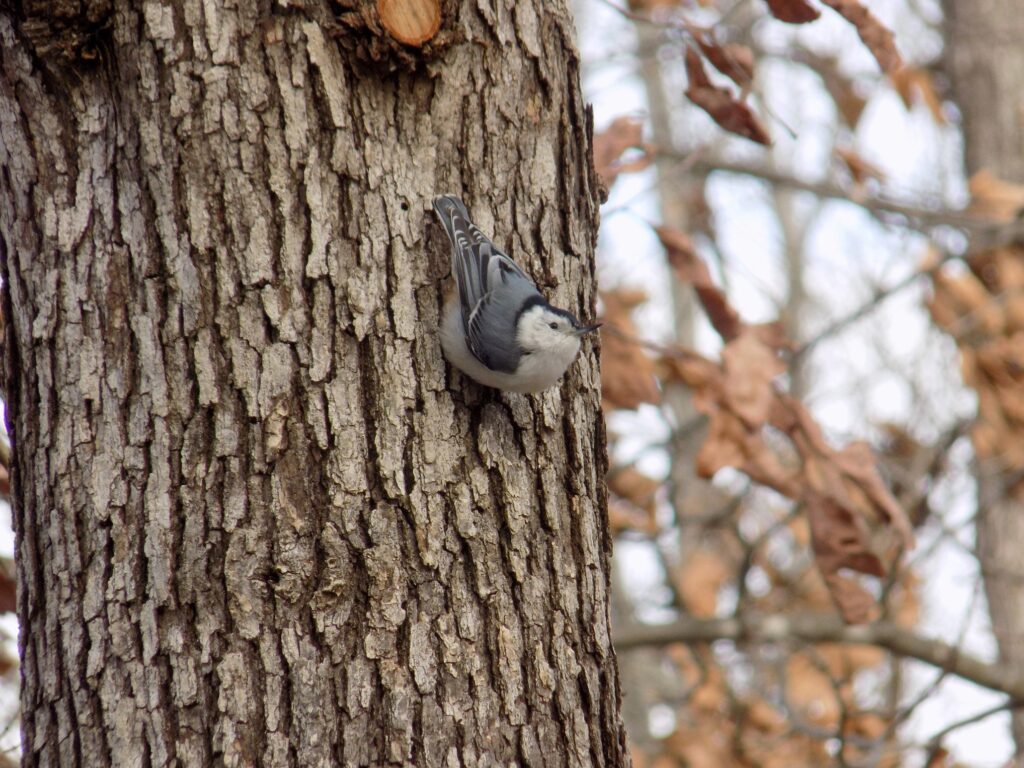
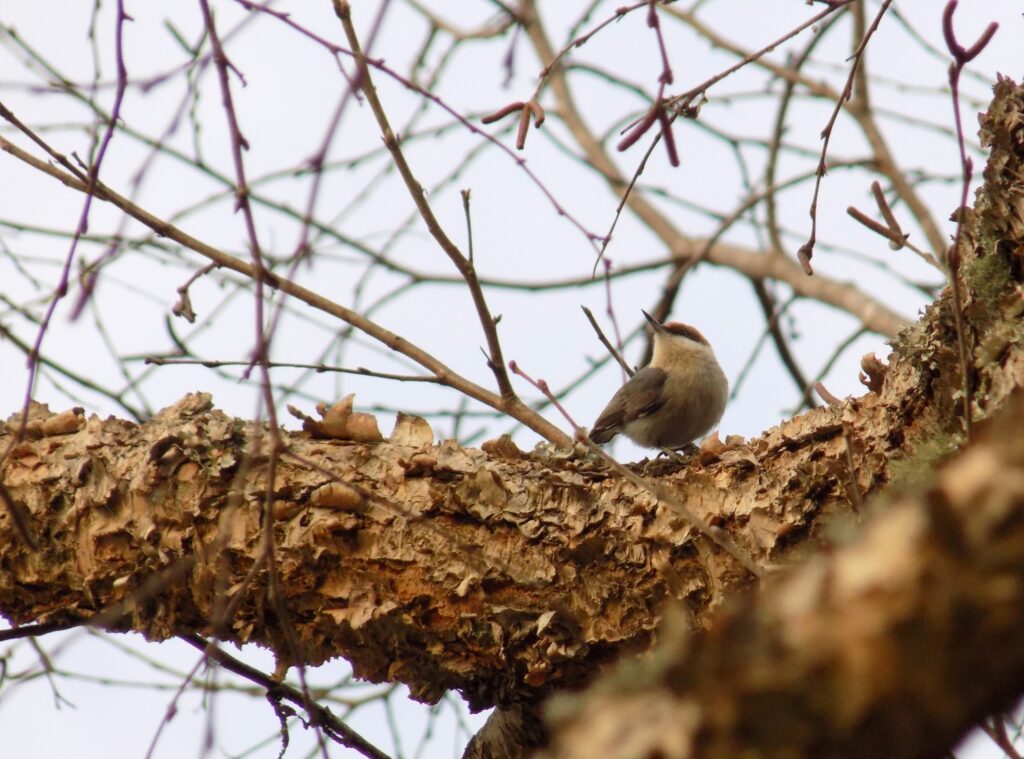
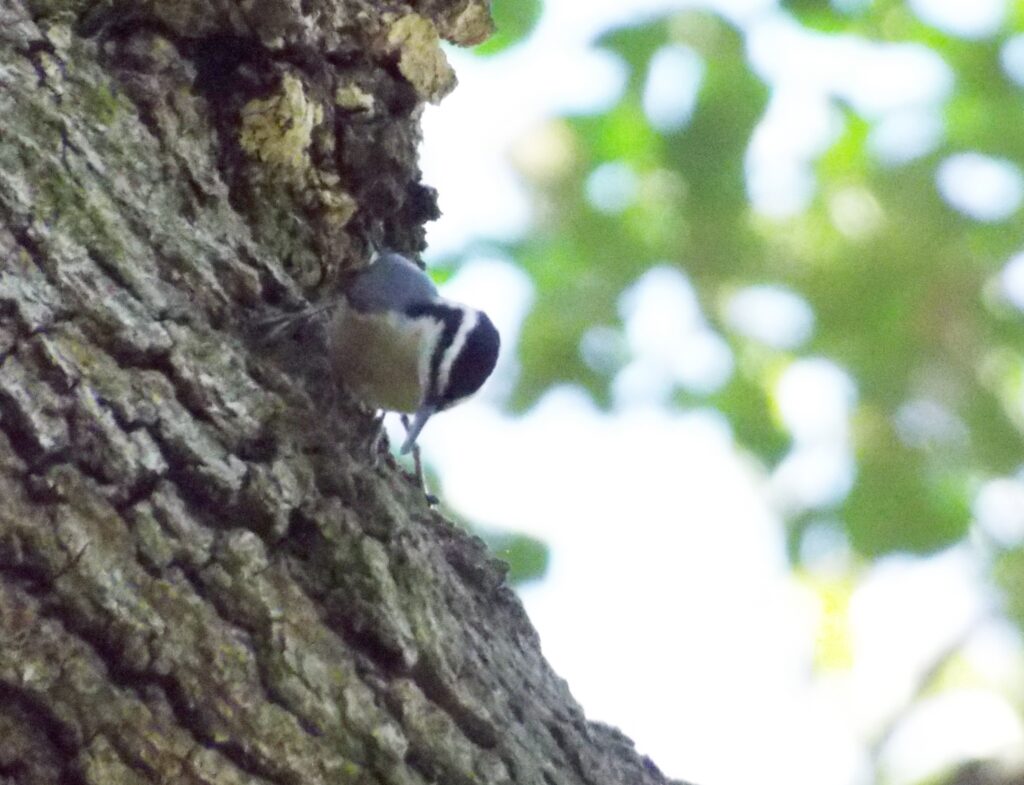


This week for Flora and Fauna Friday we have a trio of diminutive, gravity-defying, gregarious songbirds: the Nuthatches of genus Sitta.
Here in the eastern United States we have three species of Nuthatch, the White-breasted (Sitta carolinensis), Brown-headed (Sitta pusilla), and Red-breasted (Sitta canadensis). The White-breasted Nuthatch is common throughout SC, particularly in hardwood or mixed forests. The Brown-headed Nuthatch is also common throughout the state, more so towards the coast, but is partial to pine forests. The Red-breasted Nuthatch only visits us sporadically in the winter. It’s most common on the immediate coast and in the mountains.
All three of our Nuthatches are small and bullet-shaped with a blue-gray back streaked by charcoal, white cheeks, sharp bill, and beady black eyes. All in all their common names are pretty spot on descriptions. The White-breasted Nuthatch has a snow white underside, from chin to tail-tip except for rusty thighs, and a thin black cap over an otherwise unmarked face. The Brown-headed Nuthatch has a chestnut cap that reaches just below the eyes with a white spot on the nape, a white throat, and an aluminum-gray underside. The Red-breasted Nuthatch has a rust stained underside along with a black cap and eye-stripe that are bordered by matching stripes of white.
It’s also easy to pick our Nuthatches out by sound. They’re quite active, social, and vocal birds with short and unmistakable calls. Nine times out of ten if one’s there, there’s more than one and they’re making noise at each other. Our White-breasted Nuthatch gives a calls that’s best described as a dry, nasal laugh of one or more “hah”. The Brown-headed Nuthatch flat out sounds like a rubber-ducky or a dog’s squeaky toy. The Red-breasted Nuthatch sounds like a nasal bike-horn or toy trumpet.
The most interesting physical characteristic of Nuthatches are their feet and what they do with them clodhoppers. Nuthatches have long toes and an extra-long rear toe. This improves their ability to hang onto bark. Nuthatches can climb straight up a tree or straight down a trunk or around a trunk or upside-down along the whole length of a branch. To them the orientation makes no difference because those big toes give them ample traction to go anywhere they please. Nuthatches are primarily insectivores but they’ve also got an obsession with sunflower seeds. When given a supply, Nuthatches will quickly collect and stash sunflower seeds behind the flakes of bark on every surrounding tree, snacking all the while. They do the same with pine seeds in the wild. Just like Squirrels, these caches will help them through leaner times.



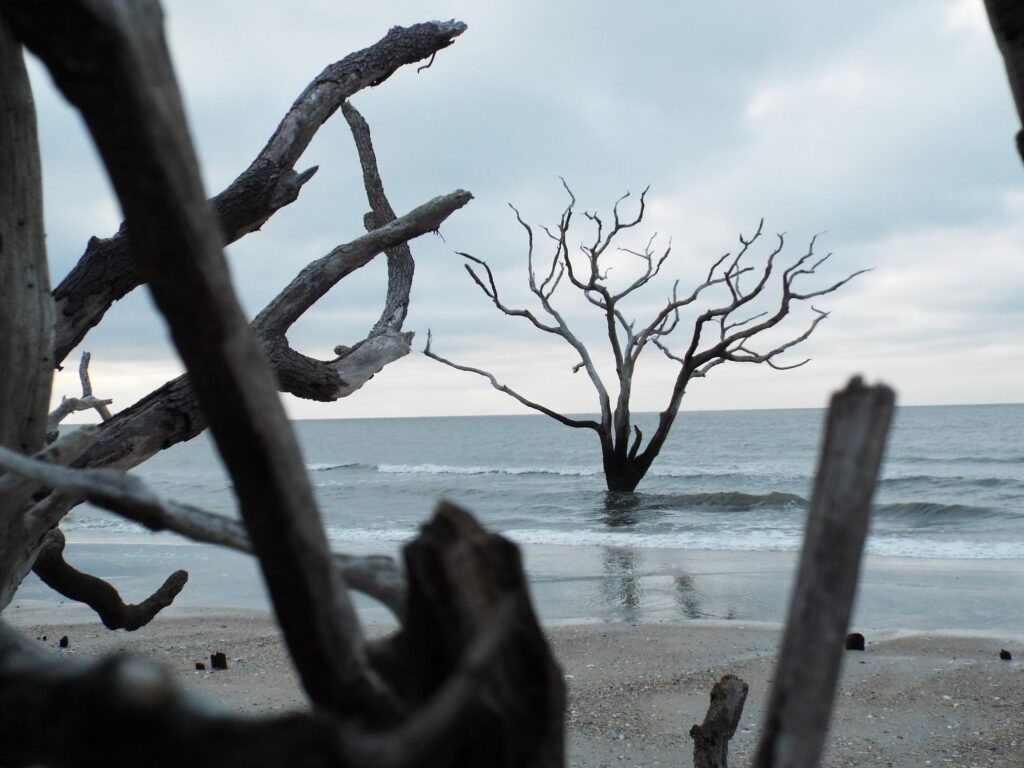
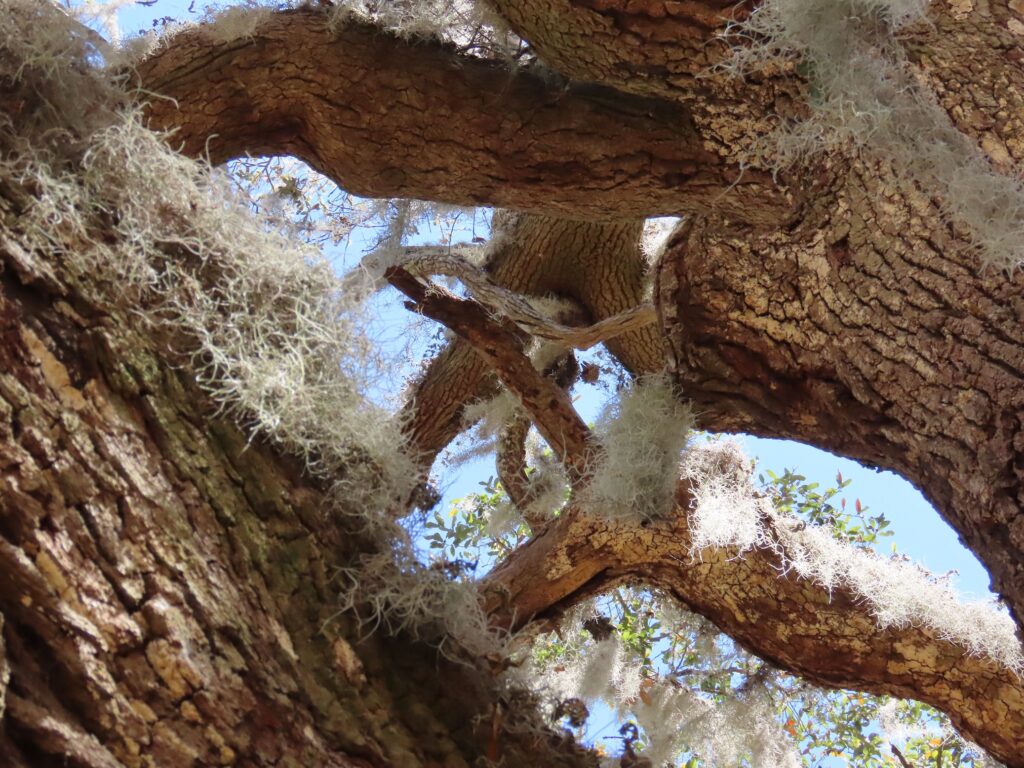
This week for Flora and Fauna Friday we have the one, the only, the irreplaceable, the Southern Live Oak (Quercus virginiana).
From the twisted boughs of scraggly hammock thickets to the sprawling ceiling of limbs around the grand multi-centennials, with trunks measured in feet rather than inches, the Live Oak is the defining organism of the Lowcountry. More than Palmettos, Shrimp, Oysters, or Spanish Moss, it is an indispensable fixture of Edisto Island. Live Oaks are massive, slow-growing hardwoods in the white oak group. Their trunks are heavy and their crown is short but exceedingly wide. Their limbs are often lumpy and gnarled in long arching spans. Their leaves are simply shaped, cupped over on their edge, leathery, and evergreen in a shade of dark inky-green shellacked with a waxy coat. Live Oaks bear sizeable acorns of a depth of brown bordering on black.
Live Oaks truly hit their stride as a tree after they break three feet in diameter. Their trunk begins to ripple and furrow over waves of coiled wood beneath. The bark thickens and fissures in great callouses of cork. Their limbs slither and spread like headwaters up a mountain as they crane and hunt for light beneath a miserly canopy. A canopy that shadows the sun and displaces the sky in a claustrophobic sarcophagus of leaves. Distended ribbons of wood bend and buckle under their own weight as branches layer upon the surrounding soil. Canyons crack and gorges gouge the walls of the Oak, peering through the ribs of the sapwood into the heartwood of a goliath. Though lightning vaporizes flesh and September gales quarter its core, our Oak brazenly flaunts its scars as badges of honor. Mere mortal wounds mean nothing more than validation to this immortal Oak.
Live Oaks grow in a wide range of habitat. From the sandhills of the midlands to the salty shores of Botany Bay. From the soggy borders of bottomlands well onto the most parching hill in the Lowcountry. They are incredibly adaptable and, save for the surf and lightning, nigh unkillable when left to their own devices. They owe much of this resiliency to their deeply extensive root system, rot-resistant wood, and dense, gnarled growth habit. These far-reaching roots let them grow as deep as they need to find water or as shallow and far away as they need to avoid water. That same elaborate root system anchors their broad canopy against hurricane force winds. That rot resistant wood is accomplished through their slow growth and sinuous vasculature, in addition to a healthy dose of resins and the like. These dense, resin saturated layers of the heartwood are difficult if not deadly for most insects and fungi to eat. Their wood’s density, in combination with its twisted shape, slows the progress of fungi and beetles within the heartwood, reducing the damage they can do. However, its overall purpose is to buy Live Oaks time to heal wounds and seal breaks. How much time? Decades if needed. Their low, sprawling growth allows them not only to maximize the amount of light they collect but also resist hurricanes. Those twisted, arching limbs have a similar utility, acting as springs that bend and flex to parry the wind rather than wholly resist it.
Just like the Longleaf Pine, the Live Oak is an ecosystem defining tree. They are the primary canopy component of our barrier islands and maritime forests. Their annual deposit of leaves enrich the soil beneath them. This mainly helps out the Live Oak but also provides needed organic matter to the soil that facilitates the growth of understory plants in barren sandy soils. They are a critical source of cover and perches for many mammals and birds. Their acorns are also a staple food of both Wild Turkey and White-tailed Deer.